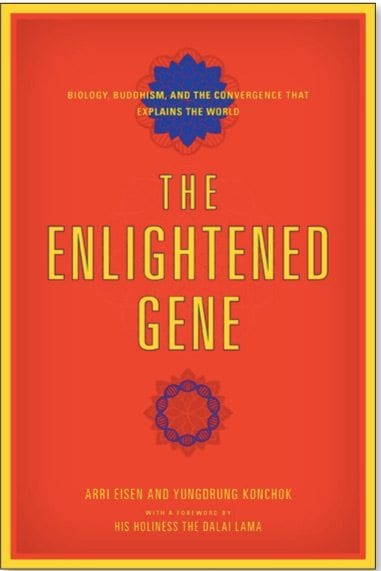Does Meditation Work?
Answering this question is complex because it involves many different disciplines, cultures, worldviews, and perspectives.
By Arri EisenDoes meditation work? I got interested in questions like this through an unusual project I helped develop: the Emory-Tibet Science Initiative. Back in the early 2000s, the Dalai Lama asked Emory University to develop a sustainable curriculum in modern science for his Tibetan Buddhist monks and nuns in exile in India. As you can imagine, this was (and still is) a challenge. How do you teach science to intelligent adults who know little to no math, equate science with the “scientism” of their Chinese oppressors, and haven’t had a significant change in their curriculum in 600 years?
The full story of our project and how it’s transformed the way we think about teaching and learning, and the interaction between science and religion, is told by me and my friend, the monk Geshe Yungdrung Konchok, in our recently published book, The Enlightened Gene: Biology, Buddhism, and the Convergence that Explains the World. Here we focus on just one part of our journey—contemplative practices and resilience—through the question “does meditation work?”
Consider the following key findings (their relevance to our question will be explained afterwards):
- People with autism are more likely than those without to have gut disorders.
- Young rhesus monkeys removed from their mothers have decreased bacterium Lactobacillus in their guts, as well as increased stress behaviors and increased susceptibility to infection.
- The cells of human mothers, who take care of their own chronically-ill children 24/7 and feel extremely stressed about it, are much older than their actual chronological age, but cells of mothers in the same situation, who don’t feel stressed, have the same biologic and chronologic age.
- The more that foster children meditate, the less inflammatory markers they have in their systems, and thus the better their immune response.
- From 1966-1995, nearly all studies on acupuncture published from Asia demonstrate a therapeutic effect, while only just over half of American studies show such positive effects.
- If your paternal grandfather consumed an excess of food for a period directly before he went through puberty, your chances of dying from diabetes are significantly increased.
- Mice who lack an immune system have defects in learning.
The shortest answer to the question “does meditation work?” is “it depends.” The answer that’s a little longer is, “it’s complicated, it depends on what you mean by ‘work,’ what is being measured, who is doing the measuring, what questions are being asked, and from what conceptual, cultural, and scientific perspective.” These points are true of most any scientific question, but they become especially important when we’re trying to address questions at the very edge of what we know and understand scientifically and can even test scientifically. Thus, we get conflicting results like in the acupuncture studies mentioned, illustrating not that any of the studies are necessarily wrong, but rather that we’re in that frustrating, but most exciting phase of complex scientific research where protocols and techniques are being refined and made consistent, where what the right questions are and how to ask them are still being resolved. The whole enterprise is made that much more frustrating and exciting because of the many different disciplines, cultures, worldviews, and perspectives involved.
 From a biologic perspective, meditation and other contemplative practices are reflective of resilience and stress response. What makes you more or less resilient—that is how well you respond to stress—is most likely related to the strength and “appropriateness” of your stress response. Regardless of how resilient you are, it appears evident from evolutionary arguments we discuss in more detail in our book and from millennia-long religious traditions that resilience and traits like compassion and cooperation are indeed traits and thus can be improved with effort.
From a biologic perspective, meditation and other contemplative practices are reflective of resilience and stress response. What makes you more or less resilient—that is how well you respond to stress—is most likely related to the strength and “appropriateness” of your stress response. Regardless of how resilient you are, it appears evident from evolutionary arguments we discuss in more detail in our book and from millennia-long religious traditions that resilience and traits like compassion and cooperation are indeed traits and thus can be improved with effort.
So, what determines resilience? If we know this, we can figure out what best to measure to see how resilient we are and if meditation then improves these measures, and to help us sort out if we can use contemplative practices both therapeutically and prophylactically.
Genetics play a big role. When I’m teaching these ideas to the Tibetan monks and nuns in India, I’ll often start by saying, “You are the fastest-evolving humans on record.” The translator translates. The room quiets. It’s not easy to live at 14,000 feet and above. The greater the altitude, the less oxygen available, and humans require oxygen to produce energy and survive. Up to 40% less oxygen is in the air on the Tibetan plateau as compared to sea level. Tibetans have, relatively quickly in evolutionary terms, evolved a number of remarkable high-altitude adaptations in less than 100 generations.
As I teach the monks and nuns—who appear remarkably resilient despite the fact that most escaped from Tibet over the Himalayas as children and haven’t seen their parents since—I wonder if it’s just a coincidence, or if there’s any link between their genetic altitude resistance and their psychologic attitude resilience.
Genes don’t exist in a vacuum, but are instead in constant conversation with their environment, and not only over evolutionary time scales as indicated in the Tibetans’ adaptation to high altitude. As strikingly, all your genes are interacting with their surroundings over developmental time—from the time you started as a sperm and egg to now—and throughout each day, as well. A big part of our genes’ environment is the microbes that co-exist within us, known collectively as the microbiome. These microbes—which far outnumber our human cells, but are as vital to us (and us to them) as our own cells—are only now beginning to be understood. Our microbiome appears crucial to our moods, thinking, biological development, and immune responses. Thus, the research mentioned above: baby monkeys’ microbiomes change when they’re lonely, autistic people have a disproportionate amount of gut disorders. Stress response and resilience might then be linked to the composition and stability of our microbiomes. Unfortunately, we didn’t appreciate that the antibiotics we’ve been using for 75 years to kill “bad” bacteria were also killing these vital symbionts.
It seems likely from such new research that our microbiomes (and their genes) are in a “triangular conversation” with our immune and nervous systems (and their genes) to monitor and regulate our stress response to environmental stimuli. It also seems likely that the “read-out” or “thing we can measure” for how well this is happening is inflammation. Even though science has artificially labeled one set of cells and organs as “the immune system” and another as “the nervous system,” these two share information, receptors, and signals all the time—with each other and our microbiomes. The example above of immune-systemless mice having learning difficulties is only one of many illustrating such connections.
How are our genes’ expression and the composition of our microbiomes “shaped” by our environments? My friend Chuck Raison, a psychiatrist who has worked on our project, posits, with others, an idea he calls the “Old Friends Hypothesis.” Chuck frames the mind-body discussion in Western medicine in terms of the “new diseases” that are now increasingly prevalent in the West—as opposed to the “old,” infectious diseases of the past. These new diseases are those that Westerners now primarily suffer and often die from. They include diseases traditionally thought of as physical—obesity, cancer, rheumatoid arthritis, and other autoimmune diseases—but also those considered mental, like schizophrenia and depression.
Why are these diseases so much more prevalent now in the West than they were just a generation ago? Here’s a hypothesis: the resilience of people like the Tibetans in our project might be due, in part, not just to their meditation practices, but also to their exposure to diverse bacteria, worms, and other micro-organisms in the rural, herding, and farming environments in which they grew up.
Life is about survival. Humans have evolved to respond to stressors; the better the response, the more likely survival, the more likely a new generation is produced. Major drivers of this evolution are bacteria and other micro-organisms—our microbiome. As noted, we’ve been killing off these good bacteria along with the bad ones. To make matters worse, at the same time, the world was becoming more and more urbanized; thus, in addition to unintentionally killing many good and evolutionary-important bacteria, humans were now exposed to many fewer kinds of bacteria and other micro-organisms in the womb and during childhood than we had been evolving with throughout previous human history.
If the immune system is not exposed early in development to what Chuck and others call “Old Friends”—these microorganisms that humans have shared space with across evolutionary time through soil, dirty water, and domestic and wild animals—the system does not learn to tolerate these microorganisms. When, because of urbanization and antibiotics, humans no longer experience these “Old Friends,” regulation of the immune system and nervous system development are altered. In combination with particular environmental and genetic backgrounds, this manifests as inflammation and the result can be increased occurrence of the new diseases. So, according to the theory, due to this dysregulation, humans have a much lower threshold for a stress response; it doesn’t take as much to “bring us over the edge” as it did in a pre-antibiotic, pre-urbanized world. Intriguing theory.
Finally, there is one more player that we’re just now learning about: epigenetics, referenced in the finding noted above about how what your grandfather experienced in terms of nutrition might affect what you die of. It turns out that many experiences we have—the memories of those experiences or a kind of special sensitivity to them—are passed on to the next few generations, not by changes in genetic code per se, but in changes to access to the genetic code. The stressful experiences you have might alter not just how you respond but also the resilience of your children, grandchildren, and perhaps great-grandchildren at the molecular level.
This brings us to those two sets of mothers mentioned above who are in equally stressful situations, but whose cells have different biological ages depending on how stressed those mothers feel. What’s the difference in these moms? Is it genetics, epigenetics, their microbiomes, immune systems, nervous systems, their experiences, their parents’ and grandparents’ and great-grandparents’ experiences? Probably.
Does meditation work? Probably—for some people in some situations by some measures. We look forward to discovering sharper answers to this question. Much of the joy is in the journey.
Arri Eisen is the Nat C. Robertson Teaching Chair in Science & Society, in Biology, the Institute of Liberal Arts, and the Center for Ethics at Emory University, where he has taught for 27 years. He is the lead biologist in the Emory-Tibet Science Initiative that has integrated modern science into the curriculum of Tibetan Buddhist monks and nuns in India. He and Yungdrung Konchok recently co-authored The Enlightened Gene: Biology, Buddhism, and the Convergence that Explains the World, from which this article is adapted with permission of ForeEdge, an imprint of University Press of New England.
